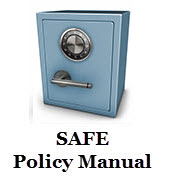|

|
State Accounting Fiscal Essentials
.
SAFE Policy Manual
|
Revised: 04/04/2025
|
State Warrant and Electronic Funds Transfer Fraud or Forgery Handling
Applicable or Related Code Sections
Related Links
PURPOSE
This policy sets forth the process for state agencies, boards, and commissions to follow when they receive notice of potential forgery or fraud activities involving warrants and Electronic Funds Transfer (EFT) payments.
Scope
This policy applies to all state agencies, boards, and commissions handling potential forgery or fraudulent payments issued by the state.
Definitions
- “Warrant”: a written order to pay a specific amount of money to a specified person, organization, or company on demand.
- “Electronic Funds Transfer (EFT)”: the digital transfer of funds from one account to another either within a single financial institution or across multiple institutions.
- "Fraud": wrongful or criminal deception intended to deceive for unlaw gain. For purposes of this policy, alteration of a warrant, negotiation of a writing falsely held out to be a warrant, and alteration of the terms of an EFT so as to divert receipt of funds to an unauthorized party are fraudulent actions.
- "Forgery": the fabrication or creation, in whole or in part, and by any means, any false writing, or the execution, or reproduction of any writing so as to be held out as authentic.
- "Issuing Agency": the agency responsible for distributing the original payment by warrant or electronic means.
- "Depositary Bank": the first bank to take a warrant.
- "Claimant": a payee or party other than a payee who can act in the payee’s place, such as someone with power of attorney for the payee, like an executor.
Provisions
A. Warrants
- Forgery
Warrant forgery occurs when a warrant is cashed by any party other than the payee without the payee’s consent.
- When an agency, board, or commission receives notification from claimant that a warrant (check) was not received and cashed by the claimant then the Issuing Agency must confirm that the warrant (check) was paid and redeemed. A copy of the redeemed warrant (check) can be obtained from Treasurer of State’s (TOS’s) Redeemed Warrant Portal. If the Agency does not have access to that site, the Issuing Agency should contact the TOS or Office of Budget and Management's (OBM’s) Payment Issuance Unit for a copy.
- The Issuing Agency must then notify TOS to begin fund recovery efforts. TOS will provide a form to be filled out while recovery efforts are initiated. If it is confirmed that the claimant is the rightful recipient of the funds and the Treasurer of State can recover the funds then the Payment Issuance Unit will work with the Treasurer of State on the forgery and will reissue the state warrant (check) in the same amount from appropriation line item 042604, Forgery Recovery. The warrant (check) will be returned to the issuing agency contact. The issuing agency is responsible for returning the replacement warrant (check) to the supplier.
- If the supplier is able to add or has a current viable EFT on file at the time OBM is able to reissue the payment, this may be used in place of a new physical warrant (check). If a viable EFT is not able to be added at the time of reissue, then the money will default to a warrant (check).
- Fraud
Warrant fraud occurs when a warrant (check) is altered in some manner or when an instrument falsely held out to be a warrant (check) is negotiated through the banking system.
- Most fraudulent activity is detected by the TOS Integrated Warrant Processing System which prevents clearance of the fraudulent instrument. Fraudulent warrants that are able to bypass the TOS system are more difficult to detect.
- When an Issuing Agency determines that a fraudulent warrant (check) has been redeemed, it should contact Ann Clymer, or her successor, if applicable, at TOS. Ann will contact the Depositary Bank and requests recovery of funds paid on the fraudulent warrant.
B. EFT
EFT is used to expedite the payment process which can make recovery difficult. Issuing Agencies must respond to EFT fraud claims promptly to ensure recovery.
- When a claimant informs an agency, board, or commission that an EFT was not deposited into the designated account and they have not received the payment in another manner, the claimant must complete the Electronic Payment (EFT) Fraud Affidavit form and submit it to the Issuing Agency.
- The Issuing Agency shall then forward the Electronic Payment (EFT) Fraud Affidavit form to:
Office of Budget and Management (OBM)
Financial Support Services
Payment Issuance Unit
30 E. Broad Street, 34th Floor
Columbus, Ohio 43215
- The Payment Issuance Unit will research the alleged fraud and collect the EFT Authorization documentation, which will receive the appropriate legal review.
- If the Payment Issuance Unit is unable to recover the funds, it becomes the Issuing Agency’s responsibility to make the payee whole.
